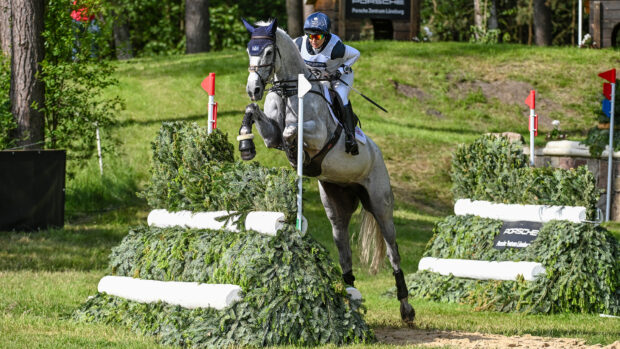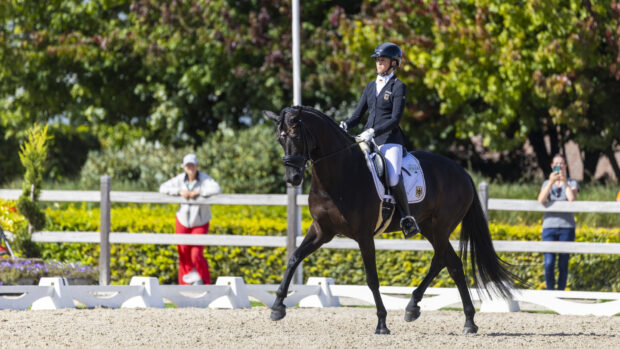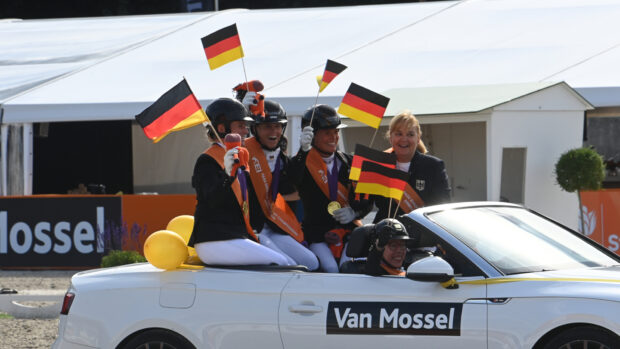Following yesterday’s statement by former Olympic champion showjumper Ludger Beerbaum, on accusations made about his training methods, H&H has sought clarification on the practice called “touching” – Touchieren in German.
The rider, who intends to take legal action after the “demonstrably false” accusations, said he was using this technique, which is allowed under German equestrian federation (FN) rules. These state that touching may help with some training issues, if carried out correctly.
In summary, touching is the application of a pole, which must comply with certain parameters, to parts of the horse’s leg during jumping to encourage the horse to flex its joints more. If the pole is held by an individual, they must be “very experienced… with a lot of routine, feeling and sensitivity”, according to the German federation’s guidelines under which the technique can be used.
“If it is ascertained that deficiencies of the rider, defaults in the throughness of the horse, lack of coordinative skills or in the jumping technique of the horse, lack of conditional abilities of the horse, the design of the basic education and training or health factors are not the reason for unclean jumping, the problem seems to reduce on a negligency of the horse due to too much routine,” the rules state. “In this case a correctly done touching might help. Touching is a professional sensitising of the horse through targeted touching of the horse’s legs during the jumping process. This stimulates a horse which has become sloppy to increase its attention and coordination again.”
The rulebook states that the horse’s Durchlässigkeit, or submissiveness/throughness, must be good, that the horse must be willing to be ridden evenly to the fence and must have confidence in its rider.
“The rider – equipped with a solid basic education – must be well capable of assessing strides when he approaches single fences. In every situation, he must be able to give the horse a secure frame with his aids,” the rule states.
“The trainer who leads the touching pole needs a good understanding of the method, must be skilled and have the right feeling for using it.
“This training aid must be used in small doses and does not substitute the actual work of the jumping horse. Daily gymnastic exercises, training for condition and the jumping of fences to improve technique and as a confidence-building measure will always be the prevailing work of a jumping horse. Touching is only allowed in training, but not at events.”
Poles used may not weigh more than 2kg or be more than 3m long. They must be round, and with a smooth surface of material that does not splinter. They must not be made of metal.
“If the touching pole is held by somebody, this may only be done by very experienced horse people with a lot of routine, feeling and sensitivity,” the rules state.
“To that end, if the above-mentioned conditions are met, a small fence is jumped. The touching pole must be raised from the height of the upper pole of the fence. The trainer who does the touching holds the touching pole in a way that either the forelegs or the hind legs are touched during the sequence of the jump. The touching must be done in the first half of the jumping sequence or rather at the highest point of the trajectory over the jump. Any contact between the pole and the horse’s legs in the second half of the trajectory should be avoided under all circumstances.”
Also allowed is the fixing of a pole that is “light, harmless to the horse, droppable and well visible”, on to the jump.
“A general insensitivity or rather a lack of disposition can also be the reason for unclean jumping,” the rules state. “This problem cannot be solved even with touching. In such cases, the horse may not be used beyond its natural disposition. If problems arise in the training of a horse, this always has a cause that needs to be analysed. These causes can be due to the horse’s state of health or history, but are usually also to be found in the rider. Even with advanced and relatively experienced riders, mistakes sometimes creep in that lead to training problems. The elimination of these must be worked on systematically.
“An incorrect basic understanding of the interrelations within riding and jumping can also be the cause of problems that arise. Therefore, self-critical analyses with the support of trainers or colleagues should be a matter of course for every jumping rider.”
The FN set up a commission in January 2021 to “deal with training methods in equestrian sport and in particular with the topic of touching”.
Rapping, a practice that is banned by the FEI, is defined “to include all the artificial techniques intended to induce the horse to jump higher or more carefully in competitions”.
The rule states: “It is not practical to list every possible means of rapping, but in general it consists of the athlete and/or dismounted assistants, for whose behaviour the athlete is responsible, either hitting the horse’s legs manually with something (no matter with what or by whom) or deliberately causing the horse to hit something itself, whether by building obstacles too large and/or too wide, setting false ground lines, placing trotting poles or the elements of a combination at a false distance, intentionally pulling or pushing the horse into an obstacle or otherwise making it difficult or impossible for the horse to negotiate the practice obstacle without hitting it.
“In the case of rapping or any other abusive schooling practice within the period of jurisdiction of the ground jury, the athlete and the horse concerned will be disqualified from all competitions for at least 24 hours. In addition, the ground jury may take any further action it deems appropriate under the circumstances, including, but not limited to, disqualifying the athlete and/or horse from the entire event.”
You might also be interested in:

Ludger Beerbaum to take legal action over ‘demonstrably false’ welfare claims

Ludger Beerbaum, and other things the horse world is talking about today

Subscribe to Horse & Hound magazine today – and enjoy unlimited website access all year round
Horse & Hound magazine, out every Thursday, is packed with all the latest news and reports, as well as interviews, specials, nostalgia, vet and training advice. Find how you can enjoy the magazine delivered to your door every week, plus options to upgrade your subscription to access our online service that brings you breaking news and reports as well as other benefits.




